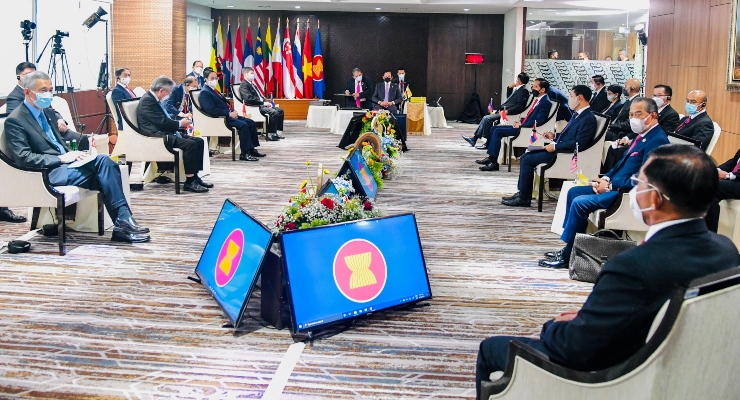
In two appearances last week, secretary of the Department of Foreign Affairs and Trade Frances Adamson laid bare the Australian government’s Janus-faced policies towards our Asian neighbours as well as our general neglect of South-East Asia.
On April 21, Adamson delivered an address to the Asia Society on South-East Asia. Keen to highlight her department’s latest lurch towards our closest neighbours, it laid out a raft of apparently well-funded initiatives, many tied up with the pandemic and its aftermath.
The big problem on everyone’s mind (the steady march of COVID-19 aside) is of course Myanmar. Adamson, who will leave the job this year for the governor’s mansion in Adelaide, rightly described a “security, political and humanitarian crisis”.
There’s no sign that horror show is abating as street protesters march on and soldiers continue to murder and detain their own countrymen despite an emergency meeting of the Association of Southeast Asian Nations (ASEAN) in Jakarta at the weekend, attended by coup leader Senior General Min Aung Hlaing. The 10-nation group called for an immediate end to the violence and laid out a five-point plan for the country, none of which is likely to come to pass.
Apart from this, according to Adamson, it was all good news from Australia’s end. Not only did she not call out Min Aung Hlaing and his colleagues, she neatly ignored the return of authoritarian, freedom-suppressing governments to most ASEAN countries not already under communist or junta rule.
More action to come
Still, this is at least diplomacy. The problem for Adamson and the Morrison government is they’re all too happy to call out Xi Jinping and China’s authoritarian leaders. A day after her South-East Asia address, Adamson’s boss Marise Payne ripped up the largely meaningless Belt and Road Memorandum of Understanding inked by the Victorian government, warning of more action to come against Chinese investments in Australia.
The reason given for the patently political move against Victoria was that, as Defence Minister Peter Dutton said on ABC’s Insiders, China does not share our values. There will be more, he and Payne said, to come. For some more consistency, let’s hope so. But one would think that the huge Chinese investments in Fortescue Metals and Rio Tinto are safe.
Yet in recent years Canberra has received Vietnam — a country whose ruling Communist Party is run along the same lines as China, who locks up dissidents, persecutes ethnic minorities and has no press freedom — in full embrace. The same can be said for Laos and its communist rulers.
The point is, there is no consistency from Canberra in the way it talks to countries in Asia. Apart from some harsh words when the Thai generals had their latest coup in 2014, business there has largely returned to normal — and so it goes for the rest of the region.
China notices such things. In Beijing’s eyes — and yes, it is important to understand this — this only serves to further undermine Australia’s credibility. The flip side is that Asia’s other leaders may also be concerned about the cavalier way in which Canberra seems hell-bent on destroying diplomatic relations with Beijing, without even the apparent promise of the US having our backs.
The problem that Adamson was effectively admitting to when she laid out the efforts that had been made in recent years was that Canberra has long take its eye off the regional ball. This was only underscored by her admission that South-East Asia has particularly been a focus for the past 12 months — so yes, everything in Canberra is that short-term.
Dwindling visits
Leaving the past year to one side, the level of bilateral prime ministerial and cabinet visits had dwindled to a sad trickle over the past decade or two, a fact regularly bemoaned by regional Australian ambassadors behind closed doors. Thailand, for instance, home to Australia’s largest consulate and a top 10 trading partner, has been ignored by every PM since John Howard.
These things matter, particularly in Asia. Australia has lazily resorted to big multilateral meetings held in big hotels. Our leaders may go to Asia but they neither really see it — visits outside major cities are almost non-existent — nor display any understanding beside the sort of platitudes Adamson was so keen to hand out. While she rightly noted that the situation in Myanmar is not only catastrophic for its own people but “imperils regional stability”, actions speak loudest.
Australia’s efforts in assisting the region following the 2004 tsunami were admirable and welcome but typical of relations with the region that have been too often transactional — the last wave of COVID-19 aid is another case in point. Other than that, these countries have been left to bump along the middle at best, despite the clear rise of China as a strategic threat.
Poor choices have been made, mostly notably the attempt to cosy up to Cambodia’s dictator Hun Sen with a $40 million gift to take refugees from Nauru — a program signed by then-immigration minister Scott Morrison in an awkward champagne ceremony in Phnom Penh. Four refugees came, only one remains.
For any serious long-term efforts in the regions, Adamson has to cast back to the ’40s and ’50s, ending her list with Australia’s excellent support for Cambodia’s peace process in the ’80s and ’90s.
The large lick of new — or rather redirected — aid Adamson highlighted is simply the return of money ripped out of South-East Asia less than three years ago (by the same PM and foreign minister) when it was hurriedly diverted to the Pacific to try and counter China’s consistent efforts. Since 2013 the Coalition has slashed Australia’s aid budgets by billions of dollars and steadily run down DFAT’s core funding; the quality and knowledge level of senior diplomats, on average, is far more patchy than it was even 20 year ago.
“Collectively, the ASEAN economies are equivalent to our second largest trading partner,” Adamson noted. It’s high time they were seen as far more than that, but perhaps it’s too late?








Never fear, Michael. The marketeer will save us from ‘the evil one’.
“The reason given for the patently political move against Victoria was that, as Defence Minister Peter Dutton said on ABC’s Insiders, China does not share our values.”
Well thank Dog for that ! Australia’s values are at rock bottom – shameful ! Our main problem is the War Mongers in Parliament taking orders from USA !
Janus, apart from being two faced, was also hermaphroditic.